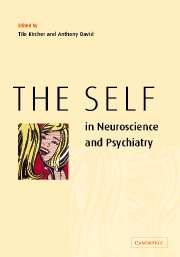Book contents
- Frontmatter
- Contents
- List of contributors
- Introduction: the self and neuroscience
- Part I Conceptual background
- Part II Cognitive and neurosciences
- 5 The multiplicity of consciousness and the emergence of the self
- 6 Asynchrony, implicational meaning and the experience of self in schizophrenia
- 7 Self-awareness, social intelligence and schizophrenia
- 8 The neural correlates of self-awareness and self-recognition
- 9 Autonoetic consciousness
- 10 The neural nature of the core SELF: implications for understanding schizophrenia
- Part III Disturbances of the self: the case of schizophrenia
- 11 Self and schizophrenia: a phenomenological perspective
- 12 Self-disturbance in schizophrenia: hyperreflexivity and diminished self-affection
- 13 The self-experience of schizophrenics
- 14 The paranoid self
- 15 Schizophrenia and the narrative self
- 16 Self-narrative in schizophrenia
- 17 Schizophrenia as disturbance of the self-construct
- 18 Action recognition in normal and schizophrenic subjects
- 19 Disorders of self-monitoring and the symptoms of schizophrenia
- 20 Hearing voices or hearing the self in disguise? Revealing the neural correlates of auditory hallucinations in schizophrenia
- 21 The cognitive neuroscience of agency in schizophrenia
- 22 Self-consciousness: an integrative approach from philosophy, psychopathology and the neurosciences
- References
21 - The cognitive neuroscience of agency in schizophrenia
from Part III - Disturbances of the self: the case of schizophrenia
Published online by Cambridge University Press: 18 December 2009
- Frontmatter
- Contents
- List of contributors
- Introduction: the self and neuroscience
- Part I Conceptual background
- Part II Cognitive and neurosciences
- 5 The multiplicity of consciousness and the emergence of the self
- 6 Asynchrony, implicational meaning and the experience of self in schizophrenia
- 7 Self-awareness, social intelligence and schizophrenia
- 8 The neural correlates of self-awareness and self-recognition
- 9 Autonoetic consciousness
- 10 The neural nature of the core SELF: implications for understanding schizophrenia
- Part III Disturbances of the self: the case of schizophrenia
- 11 Self and schizophrenia: a phenomenological perspective
- 12 Self-disturbance in schizophrenia: hyperreflexivity and diminished self-affection
- 13 The self-experience of schizophrenics
- 14 The paranoid self
- 15 Schizophrenia and the narrative self
- 16 Self-narrative in schizophrenia
- 17 Schizophrenia as disturbance of the self-construct
- 18 Action recognition in normal and schizophrenic subjects
- 19 Disorders of self-monitoring and the symptoms of schizophrenia
- 20 Hearing voices or hearing the self in disguise? Revealing the neural correlates of auditory hallucinations in schizophrenia
- 21 The cognitive neuroscience of agency in schizophrenia
- 22 Self-consciousness: an integrative approach from philosophy, psychopathology and the neurosciences
- References
Summary
Abstract
Agency is the sense of ownership, i.e. the personal experience of being the originator of one's thoughts and actions (Walter, 2001). Disorders of agency are prominent in schizophrenia and may also be part of several other neuropsychiatric disorders and syndromes, e.g. alien-hand syndrome, drug-induced psychoses or anosognosia. In recent years, cognitive neuroscience has made considerable progress in understanding the neural basis of agency. In this chapter, current neurocognitive theories of agency are reviewed which are based on the assumption that an internal monitoring deficit lies at the core of disorders of agency in schizophrenia. It is demonstrated how they fail to explain several features of disturbed agency. A complementary theory is proposed which takes into account the experiences of reference and insertion of personal relatedness as well as the acknowledged role of dopamine for schizophrenia and its role as a neuromodulator regulating signal-to-noise ratio.
The psychopathology of agency in schizophrenia
Schizophrenic patients often report the immediate experience of someone else controlling their thoughts and actions. In addition, sometimes they feel they are in control of external events or are convinced they know what other people think. They think that things or events are related to themselves in a special way, have a personal significance or are made especially for them. The German psychiatrist Kurt Schneider emphasized these types of ideation as criteria for the diagnosis of schizophrenia, and because of their relative homogeneity and recognizability, they are frequently referred to as Schneiderian first-rank symptoms.
- Type
- Chapter
- Information
- The Self in Neuroscience and Psychiatry , pp. 436 - 444Publisher: Cambridge University PressPrint publication year: 2003
References
- 5
- Cited by



